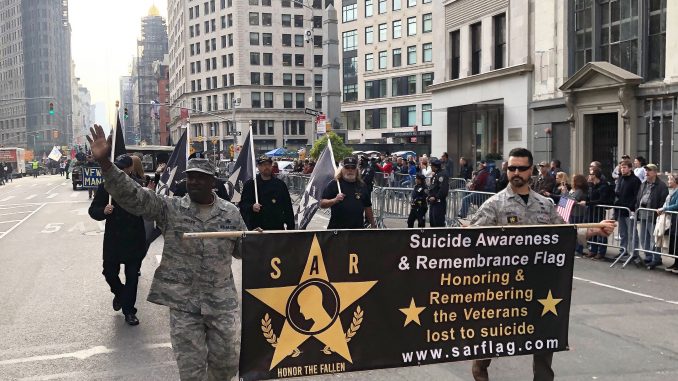
Kevin Hertell is a self-described “regular knuckle head.” He is the third generation of his family to serve in the military and served in the U.S. Air Forces for four years before serving in the reserves for another three. In the past, he imagined his future to be quite introspective and filled with hikes with his wife and two children.
But after Hertell’s cousin commited suicide and his dad survived a suicide attempt (both of whom are veterans) and Hertell learned of the statistic that every single day an average of 22 veterans commit suicide, he knew he had to do something about this troubling truth. His life has surrounded this work ever since.
After spending one year researching, six months designing and another three months making adjustments (all while working a full-time job), Hertell created the Suicide Awareness and Remembrance (SAR) flag. The flag symbolically depicts a veteran whose head is bowed in “a somber position,” facing left to pay homage to the Prisoners of War (POW) flag which helped inspire the SAR flag.
During the Vietnam War, there were several prisoners of war (POW) who went missing or were killed and their fates remained unaccounted for. In 1971 Mary Hoff pioneered the creation of a POW flag to raise awareness of POW’s and honor them, after her husband went missing at war.
Since 1982, the flag has been flown outside of the White House and federal buildings and the U.S. government has taken a greater effort to account for and identify the remains of prisoners of war. The fact that the flag led to widespread knowledge and legislative change inspired Hertell to make the SAR flag with similar intentions.
Hertell hopes that when living veterans see the flag, it provides them with hope by showing that people care and the government cares. Hertell also hopes that in hanging the flag he honors those who we have lost to suicide and their families. For civilians, he hopes to raise awareness for the staggering epidemic faced by veterans.
“There’s a warrior ethos, a warrior mentality where there’s this stigma with mental health: you keep it to yourself, you internalize it and you don’t have the proper outlet or resources to get help,” he said. “Veterans become isolated and hopeless and that’s a combination for suicide… in the military world and culture, you’re supposed to be tough and just keep pushing through. Put your head down, shut up and keep pushing through it.”
Hertell says that a symbol like this flag can be the beginning of a shift in this mentality when soldiers get back home from serving. To evolve out of the warrior mentality, the flag can remind veterans that they are not alone and there are people they can turn to. It can remind them that their struggle is not forgotten.
Isaiah Charles, an active duty soldier stationed in Cortland’s engineering unit, attests that the flag would be instrumental for veterans to see. “[Hanging the flag] would definitely show people that the country is on their side. A lot of people get back and they feel like they were abandoned by the very thing their life revolved around so seeing the flag hanging from the White House would really help.”
The SAR flag also aims to have a legislative impact in addition to an emotional and social one. For example, it could pressure the government and the Department of Veterans Affairs (VA) to do more to prevent and raise awareness for veteran suicide.
According to a Report to the Ranking Member Committee on Veterans’ Affairs, House of Representatives, the VA spent fewer than 1% of its $6.2 million allotment for media outreach regarding suicide prevention. This rate marks the lowest amount of money they have ever contributed to the outreach.
Returning to civilian life was an isolating experience for Hertell as well and he attests that if he had seen something like this flag it might’ve been different. In a military chat group he belongs to, one of the members shared something his grandmother taught him: “When all you see is negative in the world, you have to go be the good.”
This is the message that inspires Hertell to keep working day and night. He urges everyone to get involved by talking about the issue to everyone they can in order to help end the stigma. People can also tell people they know about the flag, and contact their local governments to encourage them to get the flag officially recognized.
To buy a flag or learn more about it, visit sarflag.com.
If you or someone you know is considering suicide, tell someone. There are many free resources and people to turn to. Veterans can dial 1-800-273-8255 and Press 1 to talk to someone or send a text message to 838255 to connect with a VA responder. All others can call the National Suicide Prevention Hotline at 1-800-273-8255. There are people ready to help you.

